Two Experts Share Their Tips for Improving Vision and Golf Performance
Posted by EyePromise on Jun 28th 2023
In the eye care space, EyePromise® is known for being one of (if not the most) clinically supported eye health supplement companies in the industry. As we branch out into the world of golf, we intend to keep that reputation. Our new Chief Medical and Science Officer Pinakin Davey, OD, PhD, FAAO, FARVO, partnered with another EyePromise Scientific Advisory Board member Graham Erickson, OD, FAAO, FCOVD, and published an article reviewing the science-supported ways of improving visual performance, specifically for golf. Here are their suggestions.
Correct Refractive Errors
This may seem like a no-brainer, but you’d be surprised at the number of people who need corrective lenses or an updated prescription. Refractive errors like nearsightedness and farsightedness, astigmatism, and anisometropia (when the eyes have different ocular prescriptions) can make playing sports like golf difficult. A simple eye exam can tell you if your vision (and putting performance) could be improved with a corrective lens prescription.
Beware of Filters

While many recreational and some professional golfers wear sunglasses on the course, some eyewear may have filtering effects that reduce or distort visual information, which can impact putting performance. For example, some designs have prismatic effects that may impact depth perception and even the location of the ball/hole. Some lenses can even distort the size of an object, which can critically impact putting.
Consider Sports Vision Training
Sports vision training (SVT) programs can help provide practice with demanding visual, perceptual, and sensorimotor tasks to improve performance. Afterall, practice makes perfect, right? However, Drs. Davey and Erickson caution that there’s limited and mixed support for traditional SVT procedures improving sports-relevant vision or leading to better in-game performance. When it comes to starting a SVT program, it’s best to consult your eye care professional.
Include Nutrition In Your Training Regimen
There has been significant research into the effects of nutrition on visual performance. Specifically, dietary zeaxanthin and lutein are plant-based antioxidants that concentrate in the eyes and brain. Zeaxanthin and lutein work together to filter harmful light and protect the sensitive cells responsible for crisp clear vision in the back of the retina. The concentration of these nutrients is easily measured with a two-minute, non-invasive exam with a device called the Zx Pro™.
As mentioned, dietary zeaxanthin and lutein are found in the eyes as well as the brain. Benefits of higher concentrations of these nutrients include:

Vision
- Sharper contrast sensitivity
- Improved visual acuity
- Less light sensitivity
- Faster glare recovery
- Better visual range
- Improved color vision
Neural
- Faster reaction time
- Improved visual processing speed
- Cognitive
support
- Memory
- Focus
- Decision-making
Recommendation
To get the benefits of dietary zeaxanthin, Drs. Davey and Erickson recommend getting at least 10 mg daily, with stronger benefits occurring with higher doses (20 mg). Additionally, it’s recommended that athletes at any competitive level look for products (including supplements) that are NSF Certified for Sport. This little badge ensures that you’re getting exactly what’s promised on the label, nothing more (banned substances) and nothing less (missing ingredients).
EyePromise is the #1 choice of professional athletes and eye doctors alike. Made with the highest quality, natural ingredients, EyePromise is the only performance supplement with the levels of dietary zeaxanthin recommended by experts. It’s clinically demonstrated to improve visual performance, and it’s trusted by the Boston Red Sox and players on every professional team, pro golfers Padraig Harrington and Colin Montgomerie, and collegiate teams across the country.
Learn more about EyePromise performance supplements.
There are several options for enhancing visual performance on the golf course. While this particular article focused on options for improved visual performance in golfers specifically, these benefits can apply to many other sports, as well as everyday life. For example, driving or playing video games become easier and more enjoyable with improved visual performance. Understanding the impact these options have for eye and overall health and performance can help athletes make more informed decisions.


